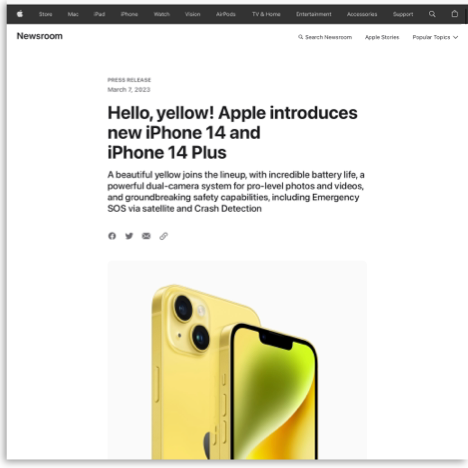
Are Press Releases Dead or Are We Just Bad at Them?
It was October 1906 when public relations pioneer, Ivy Lee, wrote the first press release about a railroad accident. That same basic approach to informing media about news and events was still the template for the industry 75-years later when I wrangled my first job in media and it remains so to this day. But in recent years, the press release has come under fire as being passé.
It’s true that capturing the attention of a hyper-targeted digital audience has become an intricate dance of strategy and creativity. Therefore, it’s not unreasonable, in the midst of this transformation, to question the relevance of traditional devices like press releases.
There’s no denying that we have witnessed a decline in the overall effectiveness of press releases for decades. The reasons behind this trend are straightforward. The Internet has caused a major shift in media consumption and values.
While media popularity varies by region, there is a consistent trend of diminishing interest in established media channels such as newspapers, television, and radio. In the United States and Europe, newspapers have been facing slumping ad sales, declining circulation, and the loss of classified advertising. Television, once a dominant source of news, has seen a decline in viewership as digital platforms offer faster and more visual news delivery. Radio, too, has been affected as audiences fragment across various media outlets.
Globally, platforms like Facebook and Google have dominated the advertising market, causing media companies to struggle with revenue stagnation and increasing costs.
The knock-on effect has been that the number of journalists worldwide has dramatically decreased – by at least 50% according to some accounts — while the ranks of communications and PR experts seeking media coverage have swelled. As a result, more and more press releases, often poorly conceived and even more poorly written, are chasing fewer and fewer journalists.
Throughout this turmoil, press releases have continued to cling to existence despite their diminishing returns.
But is it time to bid farewell to the press release? Has the practice become obsolete in today’s media landscape? Are press releases dead? Or could the issue be that many of us simply don’t know how to wield them effectively amidst a changing media landscape?
What Is a Press Release?
At its core, a press release is a primary source of information provided directly by an organization to media and, more and more, directly to its constituents. It serves as an official announcement, and its content must be relevant and intriguing enough to pique the interest of its audience. These announcements can range from product launches and brand promotions to crisis management. It’s a way for companies to say, “Hey! Pay attention, this matters.”
Most often, a press release is distributed by public relations professionals to media to pique the interest of journalists to write their own stories about the subject matter. Newswires, like Reuters, have evolved from their telegram origins to online businesses that post press releases and other announcements to the public and where journalists may monitor and pickup stories that they think are worthy of coverage. Sometimes, the press release is even reprinted all or in part by the media.
With the widespread use of the internet, companies long ago also began publishing their press releases on their own websites and today this information is amplified via social media channels.
The Relevance and Benefits of Press Releases Today
Though the average press release may be less effective in earning media coverage on its own – especially from unknown companies with stories that are not inherently newsworthy — it still serves many important purposes.
Press releases are not relics of a bygone era; they remain indispensable tools for shaping brand narratives and achieving a multitude of goals.
While poorly crafted announcements may be a waste of energy, a well-written press releases can be instrumental in building brand awareness and ensuring that every member of your team is on the same page. They provide a direct channel for your brand to communicate with the public, offering credible information and dispelling any misconceptions. A press release is still the most straightforward way of distilling your story into as few words as possible and dispensing it to media, customers, shareholders and employees. It also serves as the communication of record, passing the scrutiny of the most senior executives and guiding comments and communications about the subject for everyone concerned.
Apple regularly issues press releases to announce new products and specific product updates, partnerships, specific programs and company updates or positions. Apple also maintains its policy of absolute secrecy leading up to their announcements to ensure that each press release has maximum impact and creates a buzz that reverberates throughout the land. From the unveiling of the latest iPhone to the introduction of innovative technology, Apple’s press releases serve as a blueprint for capturing the world’s attention.

Tesla’s press releases are known for their ability to rally its fanbase and engage the public. Whether announcing record-breaking sales figures, unveiling a groundbreaking new feature or addressing concerns head-on, Tesla’s press releases serve as a vehicle for shaping its brand narrative and fostering alignment within the organization.
These examples prove that having an agreed narrative for a product announcement remains vital for even the biggest of businesses.
Versatility and Lead Generation
Press releases are incredibly versatile and can serve multiple purposes, including lead generation. Their indirect impact on search engine optimization (SEO) is particularly noteworthy. When a press release catches the eye of journalists and new audiences, it can drive web traffic to your site. If people like your content and share it, it can further boost your SEO.
Amazon leverages press releases for various purposes, including announcing expansions into new markets, launching innovative services like Amazon Prime, and sharing its sustainability initiatives. These releases not only generate buzz but also drive web traffic and bolster Amazon’s SEO, ultimately attracting more customers.
Can Press Releases Really Help with SEO?
While it’s unlikely that a press release will rank for highly competitive keywords, they can lead to valuable backlinks when media outlets and websites pick them up and write articles about them. These articles may also include links to your website.
While some of these links may be “nofollow” (i.e. carry a nofollow tag that tells search engines to ignore that link) and don’t directly benefit your SEO, they can still drive referral traffic to your site. In the past, companies flooded press releases with backlinks and distributed them widely, resulting in low-quality press releases and links. Google responded by devaluing press release links. However, using search engine optimized press releases can positively impact other ranking factors, such as building citations and protecting online reputation.
What’s more, search engines habitually crawl media outlets due to their frequent content updates. As a result, links from press releases are likely to be indexed faster. This can lead to potential backlinks and referrals gaining traction more quickly, ultimately boosting your website’s perceived authority.
When CVS Health announced its wage increases, the press release garnered attention from various media sources. Although the content may not be considered highly competitive, the novelty and relevance of the story generated interest. Readers visited the CVS Health website to explore and share the story, resulting in natural backlinks and increased authority.
Press Release Best Practices
To make the most of your press releases, consider these best practices:
- Ensure Newsworthiness
Start with a newsworthy event or story that includes elements like impact, high-profile figures, conflict mitigation, human interest, or novelty. A newsworthy press release is more likely to attract the attention of media outlets and readers. Conversely, distributing announcements that lack these attributes will teach media to ignore your press releases. - Craft an Attention-Grabbing Headline
Create a concise and engaging headline that piques readers’ interest. Avoid overused terms and clickbait, and ensure that your headline accurately represents the content of the press release. Keep it short and to the point. You can always add a subhead for clarification. - Make It Easy to Read
Follow the inverted pyramid structure, placing essential information at the beginning of the press release. Be sure to follow the established format to make your release more easily scannable by journalists. Conventional press release headlines are written in present-tense and generally exclude articles and forms of the verb “to be”. Use formatting, such as bold text, bullet points, and quotes, to enhance readability. Include a citation section with your contact information for better local SEO. - Include Visuals
Incorporate relevant visuals, such as images, videos, infographics, and interactive content, to make your press release more engaging and shareable. Visual elements can significantly increase reader engagement. - Target Relevant Platforms and Journalists
Research and target media outlets that align with your press release’s topic and audience. Consider both mainstream and niche outlets for distribution. Use press release distribution services to maximize your reach and consider a mix of free and paid options.
Press releases are not dead; they are adaptable tools that can thrive when used strategically and crafted professionally. We should continue to embrace them as cost-effective marketing assets capable of connecting with audiences, shaping brand narratives, and indirectly contributing to SEO efforts in our ever-evolving digital age.



